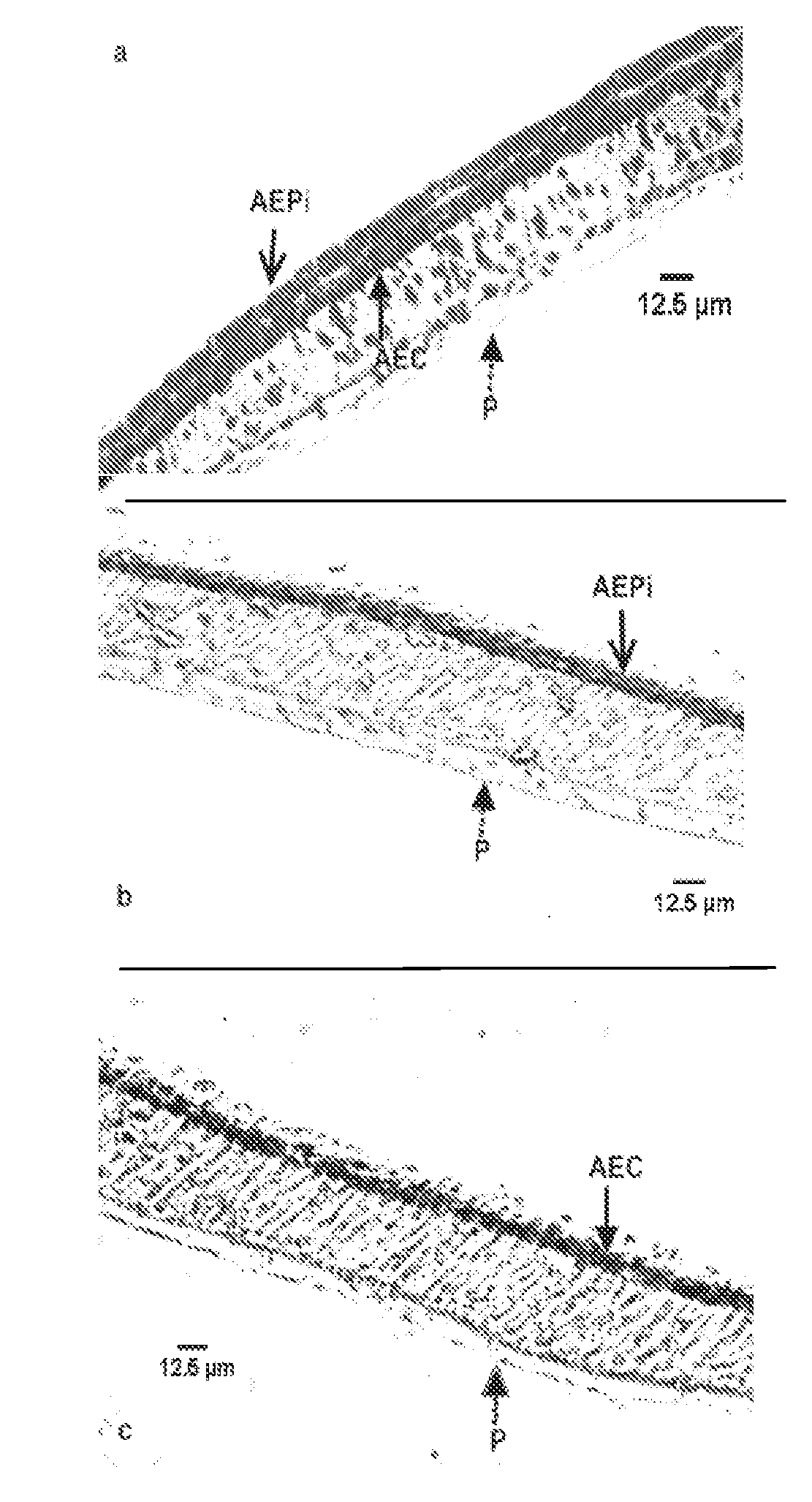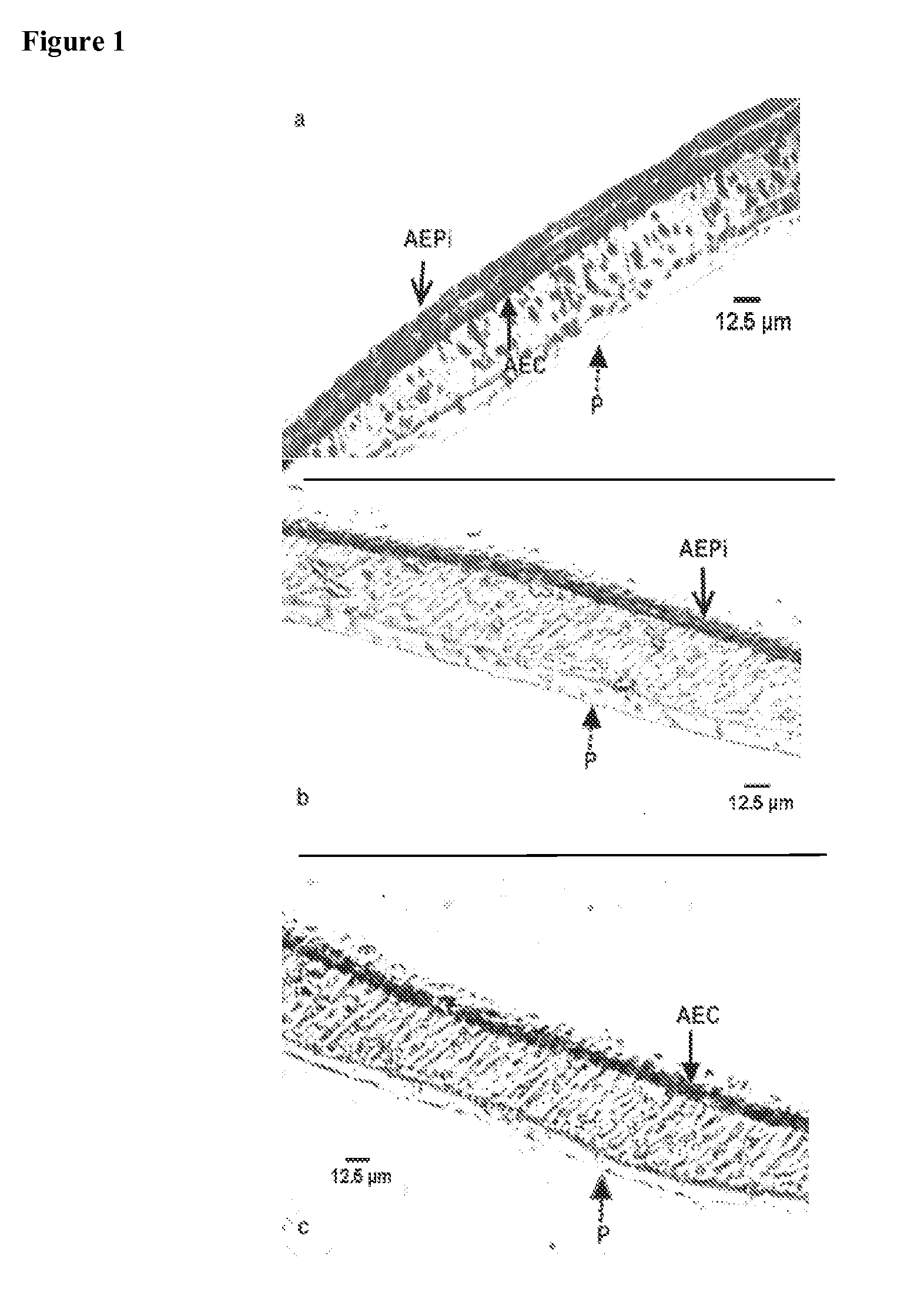Artificial tissue constructs comprising alveolar cells and methods for using the same
a technology of artificial tissue and alveolar cells, which is applied in the field of artificial or manmade models of mammalian lung tissue, can solve the problems of emphysema permanently enlarge, easy damage to alveoli, and inability to fully realize the effect of oxygen-carbon dioxide diffusion,
- Summary
- Abstract
- Description
- Claims
- Application Information
AI Technical Summary
Benefits of technology
Problems solved by technology
Method used
Image
Examples
example 1
Fabrication of Bilayer Artificial Tissue Constructs
[0101]In an embodiment of the present invention, artificial tissue constructs were prepared by creating a bilayer cellular structure on top of a collagen and laminin-coated porous plastic membrane. Primary cell isolations from normal human tissue biopsy samples were performed to isolate autologous epithelial and endothelial cells. The tissue was stored in preservation media for up to 24 h before cell isolation. The cell isolation protocol was similar to that in previous reports (Bur et al. (2006) Eur. J. Pharm. Sci. 28, 196-203; Elbert et al. (1999) Pharm. Res. 16, 601-8). Enzyme-based tissue digestion was performed with elastase and trypsin, followed by IgG panning to isolate different cell populations.
[0102]Experiments were performed with a series of extracellular matrix proteins and chitosan, a natural polysaccharide, as examples. Specifically, collagen, fibronectin, laminin, Matrigel, collagen, and chitosan-blended extracellular...
example 2
Characterization of the Constructs
[0113]Immunohistochemical staining of the mucosal construct was used to identify the presence and location of the epithelial and endothelial cells in the bilayer structure. Epithelial cells in the construct were identified by immunohistochemical staining of a number of alveolar cell-specific cytokeratins, including CK-1, 4, 5, 6, 8, 10, 13, 18, 19.
[0114]In the staining method formalin-fixed tissue was embedded in paraffin wax and sectioned at 5 μm. The paraffin wax was then dissolved with xylene and sections were blocked with ˜10% goat serum. A primary cytokeratin antibody cocktail was then added, followed by the addition of the biotinylated secondary antibody. Streptavidin-peroxidase enzyme conjugate was then applied and aminoethyl carbazole (AEC) chromagen was later added to the sections. The samples were counterstained with hematoxylin and rinsed thoroughly with dH2O and incubated until color developed. Light microscopy was used to image the cyto...
example 3
Type II Alveolar Epithelial Cell
[0117]After successfully expanding and co-culturing human epithelial and endothelial cells on laminin-coated membranes and porous scaffolds, cell morphology and activity was examined. In particular, the presence of Type II alveolar epithelial cells was studied. These cells participate in vivo in primary inflammatory and immune reactions in lung mucosa towards external contaminants and pathogens. Type II cells produce a lung surfactant substance that comprises lipoproteins and surfactant proteins able to bind polysaccharides of bacterial membranes, and enhance protective release of oxygen radicals by alveolar macrophages.
[0118]The morphology of Type I and Type II epithelial cells was examined by transmission electron microscopy of epoxy-embedded and microtome-sectioned samples of the mucosal tissue constructs of the present invention. Briefly, cultured epithelial cells were fixed with 2.5% gluteraldehyde and were later exposed to osmium tetroxide. Seri...
PUM
| Property | Measurement | Unit |
|---|---|---|
| Biocompatibility | aaaaa | aaaaa |
Abstract
Description
Claims
Application Information
 Login to View More
Login to View More - R&D
- Intellectual Property
- Life Sciences
- Materials
- Tech Scout
- Unparalleled Data Quality
- Higher Quality Content
- 60% Fewer Hallucinations
Browse by: Latest US Patents, China's latest patents, Technical Efficacy Thesaurus, Application Domain, Technology Topic, Popular Technical Reports.
© 2025 PatSnap. All rights reserved.Legal|Privacy policy|Modern Slavery Act Transparency Statement|Sitemap|About US| Contact US: help@patsnap.com



